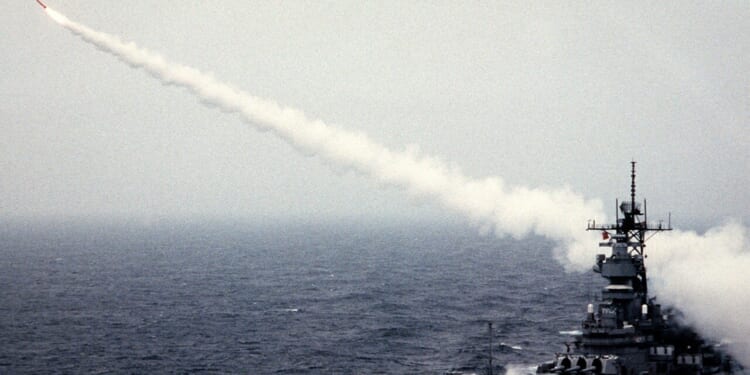The Tomahawk missiles will give Japan a powerful weapon with which to deter China. Yet the broader issue of the missiles’ short supply, and low replenishment rates, remains unsolved.
A fundamental, indeed revolutionary, shift is taking place in Japan’s military. Not since the end of World War II have the Japan Self-Defense Forces (JSDF) been so interested in rearmament. But because of the growing threats facing Japan today—notably China’s rise, the constant threat of North Korean nuclear weapons, and even an encroaching Russia on their borders—Tokyo has had to second-guess the wisdom of its 80-year-long commitment to pacifism as a national military policy.
Japan Is Inching Toward Having a Strong Military
Article 9 of the Japanese constitution nominally forbids Japan from entering war. Yet Tokyo has gradually reinterpreted that document to allow for more and more military action beyond the narrowest understanding of “self-defense.” The nation now operates a backdoor aircraft carrier, the Izumo—technically classified technically as a helicopter-destroyer, and smaller than most US Navy carriers. Nevertheless, the Izumo can deploy F-35B Lighting II fifth-generation warplanes, which have short takeoff/vertical landing (STOVL) capabilities, from its small flight deck. Japan has begun wargaming for potential conflict in their near-abroad, with the implied enemy of its wargames usually being China.
Now, the Japanese Maritime Self-Defense Forces (JMSDF) is also arming one of their advanced destroyers with US-made Tomahawk cruise missiles with a range of around 1,000 miles, according to press reports. This would give Japan’s Aegis-equipped destroyers a significant “strike-back/long-range fires” capability that would, in theory, reshape regional calculations.
In January 2024, Japan signed a Foreign Military Sales (FMS) contract with the United States to purchase up to 400 Tomahawk cruise missiles (a mix of Block IV and V variants). Japan wants to integrate these weapons into its existing fleet of Aegis-equipped destroyers. Those ships include the Kongō, Atago, and Maya-classes as well as any forthcoming destroyers under development) via vertical launch systems (VLS).
The JMSDF has already started training their crews with mock Tomahawk rounds on the JS Chōkai as part of its long journey to full integration. In fact, the Chōkai is being sent to the United States for serious software upgrades and test-firing of Tomahawks, with modifications set for completion by March 2026. Japan believes it can have all its destroyers upgraded with Tomahawks by 2027—just in time for when the Pentagon believes China will be ready to invade Taiwan. And unlike the Pentagon, Tokyo has typically met its scheduled dates on defense procurement.
Japan Needs Tomahawks—but They Won’t Be Enough
While this move by Japan represents a significant upgrade of their combat capabilities, the Tomahawks alone will not fundamentally alter the strategic balance if only because of the limitations of US Tomahawk cruise missile arsenals. And while 400 Tomahawks sounds like a significant quantity—and for a military as small as Japan’s, it is—when confronted with an enemy as large and sophisticated as China’s, 400 Tomahawk cruise missiles become less impressive.
The exact number of Tomahawk cruise missiles in America’s inventory is not publicized.
But based on procurement documents going back to 2020, one can assess that the US military’s war reserve stocks are in the low thousands—anywhere between 2,000 to 3,000 missiles as a result of the recent years of conflicts in which the Tomahawk has been one of the primary long-range attack weapons fired by the US military.
And producing these weapons, which were first made available to US military forces globally in the 1980s, is not an easy task—especially with recent increased demand placed upon this relatively limited arsenal. Baseline production capacity can replenish inventories in tens of low hundreds of missiles per year (peacetime purchases). The Pentagon has called for a surge in production of this essential weapon, saying that a few hundred will be produced every year. Although, that is with a two- to three-year lag time to get America’s defense industrial base geared up to meet that increased demand.
Tomahawks, despite being a relatively older missile system, are still very complex weapons undergirded by complex subsystems. Guidance and navigation systems, turbofan engines, seekers, warheads, datalinks, and specialized electronics are not easy systems to simply double-up overnight. Indeed, some defense subcontractors require very long lead times to meet the new need.
New production missiles undergo acceptance testing and system integration with launching platforms (ships and submarines), especially with Block V’s networking features. That, too, slows throughput compared with simple munitions. Congress and the Navy buy missiles on multi-year schedules. Sudden wartime funding can accelerate, but contracts and supply chains—the former of which are inflexible and the latter of which are extremely brittle—have to be reconfigured.
What’s more, single-source components—specialized chips, engines, and high-end sensors—are the common limiter. Historically, cruise missile production in the United States runs at dozens to low hundreds per year, depending on procurement contracts. The additional pull of Japanese military needs will enhance Japan’s ability to deter its regional foes, but will be an added (and unwanted) drain on America’s already strained arsenal of Tomahawks.
The Pentagon Should Try a New Approach to Tomahawk Production
Perhaps, eventually, the Pentagon might consider licensing the production of the Tomahawk to the advanced manufacturers of Japan to better alleviate the long-term stress imposed upon America’s critical, but dwindling, Tomahawk arsenal whilst ensuring Japan has access to these weapons in the long term.
At the same time, however, the presence of these Japanese-controlled Tomahawks on their warships, when integrated within the wider framework of the US-led military alliance in the Indo-Pacific, means that Japan will have the ability to punch well above its weight—at least for now.
Even with this increase in long-range strike capabilities, though if China continues producing their increasingly advanced weapons and platforms at the speed and pace that they have been producing at, not even 400 Tomahawks in Japan’s arsenal, paired with the other capabilities of the regional US-led alliance, will be insufficient to stop the Chinese threat to the First Island Chain. Only a reinvigoration of manufacturing both in the United States and elsewhere will ensure deterrence is restored in the Indo-Pacific.
The ability to mass produce—at affordable levels—weapons that can threaten China’s growing military will achieve this goal. Right now, neither Japan nor the United States have a defense industrial base that can meet the demands of the years to come.
About the Author: Brandon J. Weichert
Brandon J. Weichert is a senior national security editor at The National Interest. Recently, Weichert became the host of The National Security Hour on America Outloud News and iHeartRadio, where he discusses national security policy every Wednesday at 8pm Eastern. He is also a contributor at Popular Mechanics and has consulted regularly with various government institutions and private organizations on geopolitical issues. Weichert’s writings have appeared in multiple publications, including The Washington Times, National Review, The American Spectator, MSN, The Asia Times, and others. His books include Winning Space: How America Remains a Superpower, Biohacked: China’s Race to Control Life, and The Shadow War: Iran’s Quest for Supremacy. His newest book, A Disaster of Our Own Making: How the West Lost Ukraine is available for purchase wherever books are sold. He can be followed via Twitter @WeTheBrandon.
Image: Shutterstock / Everett Collection.


















